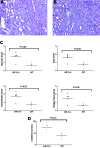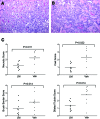Inhibition of hypoxia inducible factor hydroxylases protects against renal ischemia-reperfusion injury
- PMID: 18178798
- PMCID: PMC2391027
- DOI: 10.1681/ASN.2006090998
Inhibition of hypoxia inducible factor hydroxylases protects against renal ischemia-reperfusion injury
Abstract
Acute renal failure resulting from hypoperfusion and hypoxia is a significant clinical problem. Hypoxia activates the heterodimeric transcription factor hypoxia inducible factor (HIF), leading to changes in gene expression that promote tissue adaptation and survival. To determine whether HIF may protect the kidney from ischemia-reperfusion injury, we subjected hif1a(+/-) and hif2a(+/-) mice to renal ischemia-reperfusion injury. Injury was substantially more severe in hif(+/-) than in littermate controls, consistent with a protective role for HIF. Because wild-type mice exhibited submaximal HIF accumulation in response to no-flow ischemia, we tested compounds that might augment the protective HIF response following ischemia-reperfusion in these animals. We found that l-mimosine and dimethyloxalylglycine, two small molecules that activate HIF by inhibiting HIF hydroxylases, protected mouse kidneys from ischemia-reperfusion injury. Therefore, pharmacological activation of HIF may offer an effective strategy to protect the kidney from ischemic injury.
Figures







References
Publication types
MeSH terms
Substances
Grants and funding
LinkOut - more resources
Full Text Sources
Other Literature Sources
Medical
Molecular Biology Databases

